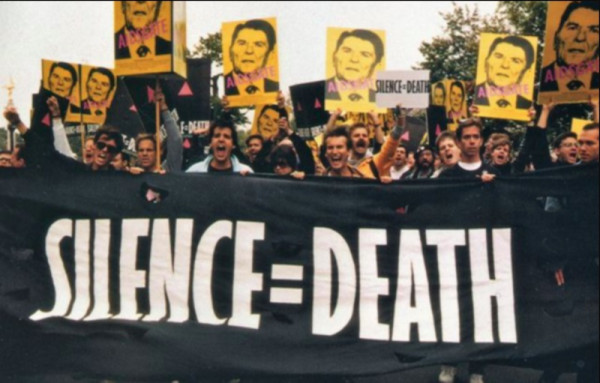
In the 1980s, the AIDS crisis hit hard, especially in the gay community. Many in that community, then and now, point to President Ronald Reagan as a key reason the epidemic spiraled, claiming he “did nothing” to stop it. It’s a knee-jerk trope in the gay community up until this very day where AIDS-HIV is still, after over 40 years, not a fully curable disease.
This belief stems from real frustrations but oversimplifies a complex issue. The idea that a president – in this case Reagan – talking about a disease makes it curable doesn’t hold up when you look at the science and history of AIDS.
What Was Known About AIDS in the Early 1980s?
When AIDS first appeared, doctors didn’t know what they were dealing with. In 1981, the CDC reported unusual cases of rare infections and cancers in gay men, initially calling it GRID (Gay-Related Immune Deficiency).
By 1982, it was clear the disease wasn’t limited to gay men—it was seen in hemophiliacs, intravenous drug users, and others. Scientists didn’t identify HIV as the cause until 1983, and a reliable test for the virus wasn’t widely available until 1985.
Early on, no one knew how it spread, whether it was contagious through casual contact, or what could treat it. The medical community was scrambling to understand a new disease with limited tools. Doctors and researchers, not politicians, were the ones tasked with figuring this out.
By 1983, the National Institutes of Health (NIH) was funding studies on AIDS, and pharmaceutical companies were racing to develop treatments. This was their job. Science, not speeches, drives medical progress. Expecting Reagan to expedite a cure was unrealistic when even experts were years away from effective therapies.
Reagan’s Response: What He Did and Didn’t Do.
Reagan’s critics argue he was silent on AIDS, ignoring the crisis while thousands died. The facts show a mixed picture. Reagan first mentioned AIDS publicly in 1985, four years after the first cases were reported. His administration didn’t request significant AIDS funding until 1986, when $86 million was allocated for research and prevention. By 1987, federal spending on AIDS reached $500 million, and Reagan signed off on initiatives like the CDC’s prevention campaigns. However, early budgets were tight—NIH funding for AIDS in 1983 was $44 million, far less than activists wanted, given 1,500 reported deaths by then.
The gay community’s anger wasn’t just about funding. Reagan’s silence fueled perceptions of indifference, especially since AIDS hit marginalized groups—gay men, drug users, minorities—hardest. His administration’s slow response to public education and delays in approving drugs like AZT (approved in 1987) added to the frustration.
Activists, like those in ACT UP, pushed hard for action, feeling the government wasn’t moving fast enough. They weren’t entirely wrong—bureaucratic delays and stigma slowed things down—but the idea that Reagan’s inaction caused thousands of deaths ignores the bigger picture.
Why Blaming Reagan Persists.
The narrative that Reagan “did nothing” sticks because it’s emotionally powerful. The gay community faced devastating losses—over 20,000 Americans died of AIDS by 1987—and felt ignored by a conservative administration. Reagan’s ties to religious groups, some openly hostile to gay people, didn’t help. His silence was seen as a moral failure, amplifying pain in a community already stigmatized. When he finally spoke, it was too late to undo the perception of neglect, but the belief that a president talking about AIDS would have led to an earlier cure is flawed. Medical breakthroughs don’t work that way, and as stated before, AIDS is still, in 2025, not a curable disease. Yes, it’s highly treatable and millions of loved ones are living long and productive lives, but the ghost still lingers.
AZT, the first HIV drug, took years to develop because scientists needed to understand the virus, test compounds, and run trials. Even with more funding, the timeline wouldn’t have shifted much—drug development takes time.
For example, effective combination therapies (cART) didn’t arrive until 1996, under Clinton, after a decade of research. No speech could have sped that up significantly. The Role of Science and Big Pharma-Doctors and pharmaceutical companies were working on AIDS from the start, not because of political speeches but because it’s their business.
By 1984, researchers like Dr. Robert Gallo and Dr. Luc Montagnier identified HIV, a critical step. Companies like Burroughs Wellcome (now GSK) developed AZT, approved in 1987 after trials showed it slowed HIV progression. These efforts happened regardless of Reagan’s public stance. Funding helped, but science, not politics, drove the breakthroughs.
The gay community’s activism was crucial, pushing for faster drug approvals and more research dollars. Their pressure led to changes, like the FDA’s accelerated review process in 1987. This shows the community wasn’t just blaming Reagan—they were fighting for solutions, often against a slow bureaucracy.
Why the Trope EnduresZ:
Lay people, those outside medicine, often think a president’s attention can solve a disease. It’s a natural misunderstanding—leaders set priorities, and visibility feels like action. But in the 1980s, AIDS was a scientific puzzle, not a policy fix. Reagan’s slow response and silence hurt morale and delayed some resources, but the idea that his inaction directly caused thousands of deaths oversimplifies things. Scientists were limited by the era’s technology, not just politics.
The gay community’s pain was real, and Reagan’s leadership fell short in addressing it, but pinning the epidemic’s toll on him alone ignores the broader challenges of an unknown virus.
Today, some still hold Reagan responsible because the wounds are fresh, and the narrative is a rallying point. It’s less about science and more about feeling heard. Understanding this split—between medical reality and emotional truth—helps explain why the blame persists, even if it doesn’t fully align with how diseases are tackled.



